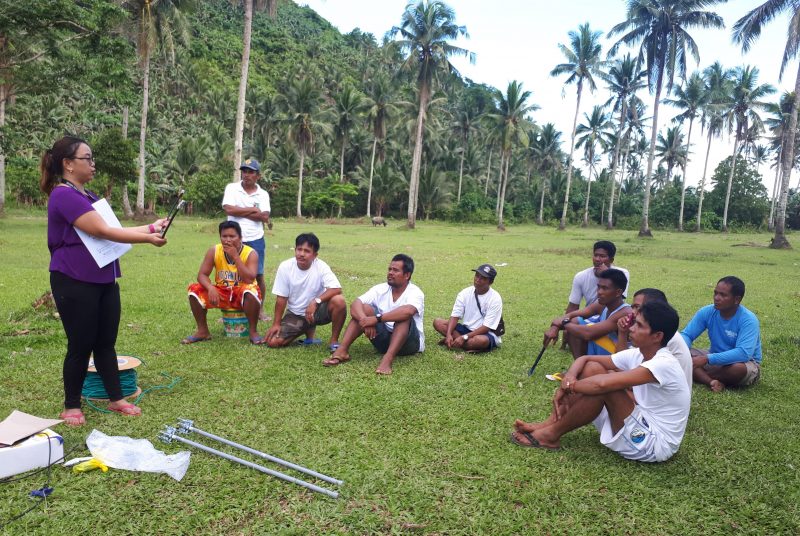
Technical training with the local community. Photo provided by PCARI-VBTS PH and used with permission.
Rising Voices (RV) is partnering with the Association for Progressive Communications (APC) which produced the 2018 Global Information Society Watch (GISWatch) focusing on community networks defined as “communication networks built, owned, operated, and used by citizens in a participatory and open manner.” Over the next several months, RV will be republishing versions of the country reports highlighting diverse community networks from around the world.
This country report was written by Mary Claire Barela, Josephine C. Dionisio, Kurtis Heimerl, Manuel Sapitula, and Cedric Festin. Please visit the GISWatch website for the full report which is also available under a CC BY 4.0 license.
Despite the rapid expansion of mobile coverage throughout the world, roughly 10% of the world’s population lives beyond the reach of a cell tower. This is particularly problematic in the Philippines, with just under 70% mobile phone penetration. Because these isolated and relatively poor communities are not considered commercially viable within the current business and technology model of commercial operators, bridging this “last mile” connectivity gap requires innovative technological solutions.
To combat this, our team, in partnership with a local telecom and local communities, has developed and deployed GSM community cellular networks (CCNs) in the rural Philippines. The CCNs deliver basic mobile telephony at a fraction of the capital and operational expenses of traditional cellular networks by including local agents in the operation of the network. To prove the importance of cellular access, we are also evaluating the impact of cellular connectivity in our partner communities, specifically across gender and social networks, through the use of a longitudinal randomised control trial and participatory qualitative research.
Our CCNs are deployed in the rural and isolated barangays of Aurora Province, Philippines. Each barangay has a cell site that provides cellular coverage to the entire community. The system is powered via solar and is connected to a VSAT backhaul to route calls and SMS to the broader public telephone network. The network, dubbed “VBTS Konekt Barangay”, has been in operation for over seven months and with more than 1,200 subscribers. To date, four out of the seven pilot sites have been launched (Brgy. Umiray in September 2017, Brgy. Dikapinisan in October 2017, Brgy. Dibut in February 2018, and Brgy. Diotorin in May 2018). All seven pilot sites are expected to be operational by end of 2018.
Policy, economic and political background
Our biggest challenge is the lack of an operational framework that supports last-mile service delivery in the context of community networks. The Public Telecommunications Policy Act of the Philippines, which governs the development and delivery of public telecommunications in the country, states in its policy declaration that “expansion of the telecommunications network shall give priority to improving and extending basic services to areas not yet served.” Since our network uses regulated GSM frequencies to operate, another large challenge is the lack of available spectrum that can be assigned to CCNs and allow them to operate legally. In the Philippines, all channels on GSM mobile cellular bands (900/1800/2100 MHz) have been allocated to incumbent mobile network operators. On top of this, licences cover the entire country with no “use-it-or-lose-it” provisions, forbidding local actors. As such, even in areas where these telcos have no presence, small-scale cellular networks cannot just operate without coordinating with the regulatory agency and the assigned frequency owner. The creation of policies to support rural connectivity (such as a universal access fund or spectrum sharing) would help in extending basic communication services in the country and is actually part of the mandates of the law. The Philippine Department of Information and Communications Technology and the country's regulatory agency, the National Telecommunications Commission (NTC), have yet to formulate a new policy on “refarming” and redistributing the spectrum that will foster better delivery of communication services in the country or on the creation of a universal service fund.
The current framework presents myriad barriers for small, community players to participate. To be able to operate telecommunications services, an organisation will have to first secure a congressional franchise and a certificate of public convenience and necessity (CPCN) which will prove their financial, technical and legal capability to offer the proposed services. On top of this, carriers (including small local operators) also have a number of other licences they must acquire for operation, including environmental clearance certificates, height clearances, and the local mayor’s permit. All in all, there are as many as 25 permits needed for each cell site. The sheer number of required permits is very difficult for a small entity to complete.

A VBTS engineer takes the lead in the technical training. Photo provided by CARI-VBTS PH and used with permission.
In the past, access initiatives in the Philippines have concentrated on providing internet access to remote and rural parts of the country. These networks typically employ point-to-point, long-range Wi-Fi links to connect institutions, such as schools, to the nearest internet point of presence. One example is the Digital Provide initiative, where secondary schools in Batanes were connected to the internet service provider using long-range Wi-Fi links. These initiatives were largely “top-down” in nature and focused on basic IP connectivity rather than community ownership. Over time, the expansion of mobile internet access in suburban and provincial areas has rendered some of these networks inactive.
Engaging partners and community participation
Our first major innovation is our public-private partnership for sharing cellular spectrum with a large mobile operator. Given the absence of regulatory support and spectrum access for community cellular networks in the Philippines, we found it necessary to find a partner that shares the project’s vision and that would allow the community network to operate under their frequency licence. We found that partner in Globe Telecom, a major telecommunications company in the Philippines. Since our sites have a smaller subscriber base than what it would consider viable, our community network deployments are placed under its corporate social responsibility programme.
Our engagement on the ground is founded on the sustained collaboration between several institutions: higher education institutions such as the University of the Philippines (UP) and Aurora State College of Technology (ASCOT), the telecommunication company (Globe), local government units at municipal and barangay levels, and operational cooperatives in the area. Through top-level agreements, Globe consented to the use of 2G frequency under their franchise. In addition, Globe allowed us to use their SIMs and cloud services which provide the interconnect from the VBTS network to other phone networks. Globe is also assisting the project to comply with the required NTC permits, such as radio station licences and pricing approvals.
Partnership with local government units at the municipal level is crucial because of their administrative authority over the project sites. In rolling out the infrastructural requirements of the CCNs, municipal mayors facilitated the legal appropriation of lands where the towers were allowed to be built, and helped expedite the issuance of various permits and clearances for construction of the village base stations within their areas of jurisdiction. The municipal governments helped mobilise local labour that assisted university-based engineers and also helped identify potential partner cooperatives based on track record in project management. In due course, the municipal governments allocated funds in their annual budget for the maintenance of the village base station towers and for the mobilisation of community-based civilian security forces to protect the towers and CCN-related equipment from possible theft and vandalism.
Cooperatives with municipal-wide operations are one of many types of organisations at the ground level, alongside tribal councils for the indigenous peoples’ communities, and associations of fisher folk and farmers. Municipal-level cooperatives were chosen as acceptable project partners, especially for telecommunications, because of their established juridical personality which made them eligible to establish business transactions with Globe, and because of their familiarity with administrative requirements in managing income-generating activities. They were enjoined to handle the day-to-day operations, business management, and maintenance of the community network, while systematically building the capabilities of community-level associations so that these associations may eventually exercise greater control and accountability over the CCNs.
The cooperatives are in charge of the SMS-based electronic load (e‑load) distribution from Globe to the local retailers. The cooperative orders the e‑load from Globe on a monthly basis. After the cooperative’s mobile number has been topped up, the cooperative then distributes it to authorised local resellers in the communities. The cooperative receives a wholesale discount from Globe, which in part is also passed on to the community retailers. Finally, the gross revenue from all charged calls and texts on the network are split based on an agreed revenue-sharing scheme between Globe and the communities. In the revenue-sharing scheme, the cooperative gets 80% while the remaining 20% goes to Globe. Earnings are used by the cooperative to pay the honoraria of community personnel and as savings for operating expenses beyond the subsidised first year.
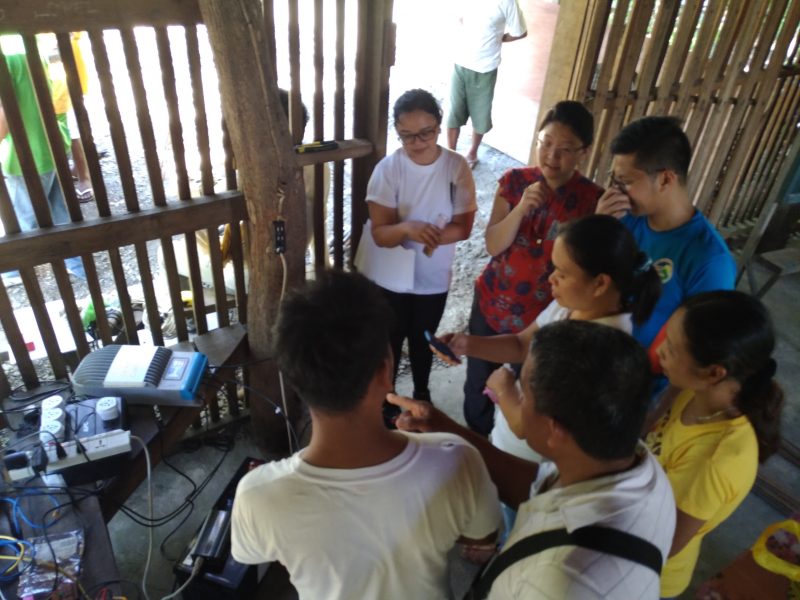
Technical training with local cooperative members. Photo provided by CARI-VBTS PH and used with permission.
The majority of our retailers are women (eight out of ten) and are already running their own sari-sari or general merchandise stores. Aside from the retailer’s discount, the retailer also charges an additional convenience fee per transaction to the subscriber, which is a common practice in the Philippines. On top of e‑load sales, some retailers grabbed the opportunity to sell mobile phones and mobile phone accessories in their area.
During onboarding, local stakeholders are first oriented on the goals of the project, with emphasis on community ownership and public service over profit. Prior to launch, social science researchers facilitated social enterprise training sessions with cooperatives that had no prior experience in conducting business-related activities pertaining to the selling of SIM cards and cellphone load. VBTS engineers conducted trainings with community maintenance personnel (Level 1) and with ASCOT engineers (Level 2). The scope of Level 1 revolves around daily maintenance and basic troubleshooting of the CCN tower and equipment, which will be performed by community site operators. The scope of Level 2 consists of tasks which require intermediate technical knowledge or tools to complete. Technical personnel will coordinate with higher levels for incidents or issues that they cannot resolve at their level. It was later clarified during a technical breakdown that municipal engineers will need to be closely involved in troubleshooting hardware-related concerns, which will aid in the efficiency of the CCN system.
On the day of the network launch, we hold a small programme wherein we introduce the community network, its capabilities and limitations. The launch events are well attended by community members, and become useful venues to introduce our on-ground partners (retailers, maintenance) and address questions and concerns from the community. Post-launch, we also open an SMS-based support hotline. This SMS-based service is free and open to all subscribers in the community. Aside from being a channel for community members to send network-related inquiries, this is also being used to send questions, suggestions or other feedback to the project team.
Usage trends
Currently, we have more than 1,500 subscribers, equivalent to more than 81% of the total eligible population (15 years old and up) across all operational sites. About 40% of the subscribers top up monthly, spending USD 1.20 per month. Monthly average revenue per user is around USD 0.60. We have seen strong usage and adoption in sites that are tremendously isolated and where the VBTS network is their only means to communicate out of the barangay. In areas where an alternative service is less challenging to access, subscribers are not dependent on the community network, as they can get an incidental signal from other networks by walking several kilometres.
In terms of network traffic, we have observed that subscribers take more inbound calls than they make outbound calls – the number of inbound calls minutes is six times greater than the number of outbound call minutes. This is indicative of a “call-me” behaviour where subscribers in the community let their outside contacts call them instead of making a call themselves, taking advantage of the fact that receiving inbound calls is free. SMS traffic, on the other hand, has the same volume in both directions. Over time, we have observed a general trend of outbound calls and bidirectional SMS traffic reaching a steady state, but the level of incoming calls continuing to increase. Subscribers are also budget-sensitive and, as a result, there is a request for value-for-money promos, such as the “unlimited” call and text bundles offered by conventional networks.
Technology platform
The second innovative part of this project is the technology platform. We have chosen to leverage the CommunityCellularManager (CCM) stack, a novel IP-based cellular core. CCM allows for multiple individuals to run separate community networks under one technical domain and is split into two technical portions: the client and the cloud. In our case, Globe manages the CCM cloud installation and provided us an account for our networks. We manage the client installations, porting the client to a variety of compatible hardware platforms (Nuran Litecell, Endaga CCN1, Fairwaves UmSITE). We developed additional software-based client features that are necessary for field operations and to assist with the implementation of our research and evaluation needs, including call and text promo support. The CCM cloud handles the routing, interconnect, and phone numbers for our network (and other Globe community-style installations) – generally anything having to do with the integration into the Globe network. This is the first large-scale CCM deployment in the world. Our team led the integration work with Globe and assisted it in the installation and operation of both the cloud and client inside of its network.
Social impact
Our mixed-methods approach to social impact evaluation of the installations, using a randomised control trial and participatory qualitative research, is another novelty of this network. In the past decade, roughly four billion individuals in developing countries have started using mobile phones for the first time. While qualitative evidence of the impacts of network access is abundant and clear, outside of a few well-cited papers about phones and agricultural market inefficiencies, there is a lack of rigorous (e.g. randomised control trial) empirical evidence on how mobile phones affect the social and economic outcomes of individuals and households. This is in part due to the difficulty in measuring the causal effects of mobile phone adoption, since the market-driven spread of mobile phones is not typically exogenous to economic outcomes. Together with a team of economists and social scientists, we are working to develop a rigorous body of evidence of the social and economic impacts that the mobile phone network brings to communities in the rural Philippines.
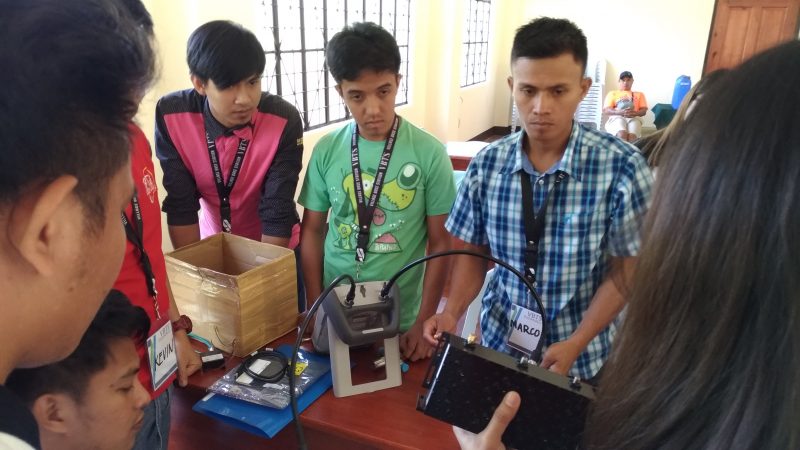
Advanced training with the local state college. Photo provided by CARI-VBTS PH and used with permission.
Though much of the evaluation has yet to be completed (with the endline survey expected six months after the installation of the last site), we have noted some immediate effects. The most obvious impact is in the enabling of communications in the communities. Prior to the arrival of the network, locals would need to travel several hours by boat or rough roads before they could reach an area with a cellular signal. Now they enjoy a more accessible and convenient way to get in touch with family and contacts outside their barangay. The community cell service has also helped the barangay council report faster to the municipal government and vice versa.
But more than communications, the CCNs also enabled social capital formation. The presence of the CCN has the potential to contribute to a more vibrant local economy as alternative sources of income are spurred through the selling of mobile phones and mobile phone accessories, and the provision of repair and maintenance services. Also, the community cellular service has the potential to connect previously disparate communities into an established network of value chains.
Our trainings are not only limited to transferring technical knowledge, but are conducted on different levels and on different dimensions that involve imparting the message of community benefit and ownership. Aside from training the partner cooperatives and on-the-ground personnel, we also extended our training to the local government units and to nearby higher education institutions. More than being respondents to the technical difficulties of the installations, the advancement of their skills and knowledge is crucial for their future research and interventions that would attend to the needs of the community. The collaboration of knowledge and skills from the institutions brings new ideas and appropriate applications that matter to the local community, which is the goal of this inclusive effort.
Our experiences in the implementation of the project render more visible the social infrastructure requirements for replicative and sustainable CCNs. We have encountered challenges in setting up the business model and structure, as well as creating a feasible trade and distribution network, as these sites are far away from traditional financial institutions like banks and remittance centres. Our partner telco also has internal vendor certifications, trade requirements and processes that our on-the-ground partners need to satisfy. Because of this there is a need to acknowledge the distinct nature and “business model” of CCNs which should be viewed differently from how traditional and large telecommunications organisations normally operate.
Conclusion
We believe our experiences contribute a unique perspective on community networks in three ways: 1) by involving a novel public-private spectrum licensing partnership between the UP, Globe Telecom and the local communities; 2) using the CommunityCellularManager cellular stack to provide 2G basic cellular service including voice, SMS and, eventually, data; and 3) a mixed-methods approach to social impact evaluation of the installations using randomised controlled trial and participatory qualitative research.
These factors have allowed us to sustainably provide cellular coverage to one of the most remote areas of the Philippines, and an area that incumbent telecoms are unable to profitably serve. It has also allowed us to help empower the communities themselves to own and operate their own telecom equipment. We plan to continue to scale the CCN solution in the Philippines and hope to continue to have deployment experiences to share.
For more information regarding action steps to support the continued development and sustainability of community networks in the Philippines, please visit the full report on the GISWatch website.

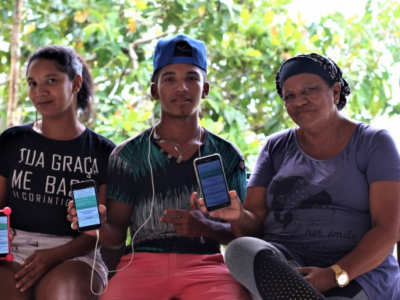
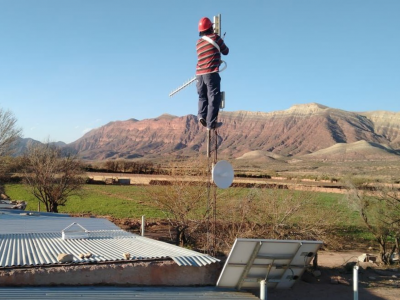

2 comments
Dear Sir/Madam,
I am writing to please help us install a signal connection to our Barangay Tigao, Cortes, Surigao del Sur, Philippines 8313. I am currently living here in New Zealand and communication is very important to connect with my family, friends, and relatives. I don’t see any reason that our Barangay will not be accessible to satellites as it is located along the highway. We are not living in a far flung areas so I can say that it’s really easy I think fo install. Please help us Tigaonons to live a comfortable life through easy communication. Thank you! I will be very happy in anticipation of your reply. Godbless!
Jusie
Dear Maam/Sir,
This project is an inspiration. I came from the remote town of Romblon. We often have a problem because the only 1 telecommunication cell site was installed in our town. I am curious and I am interested to apply this project to our community. I hope to hear from you.
-Jennet R. Rabo